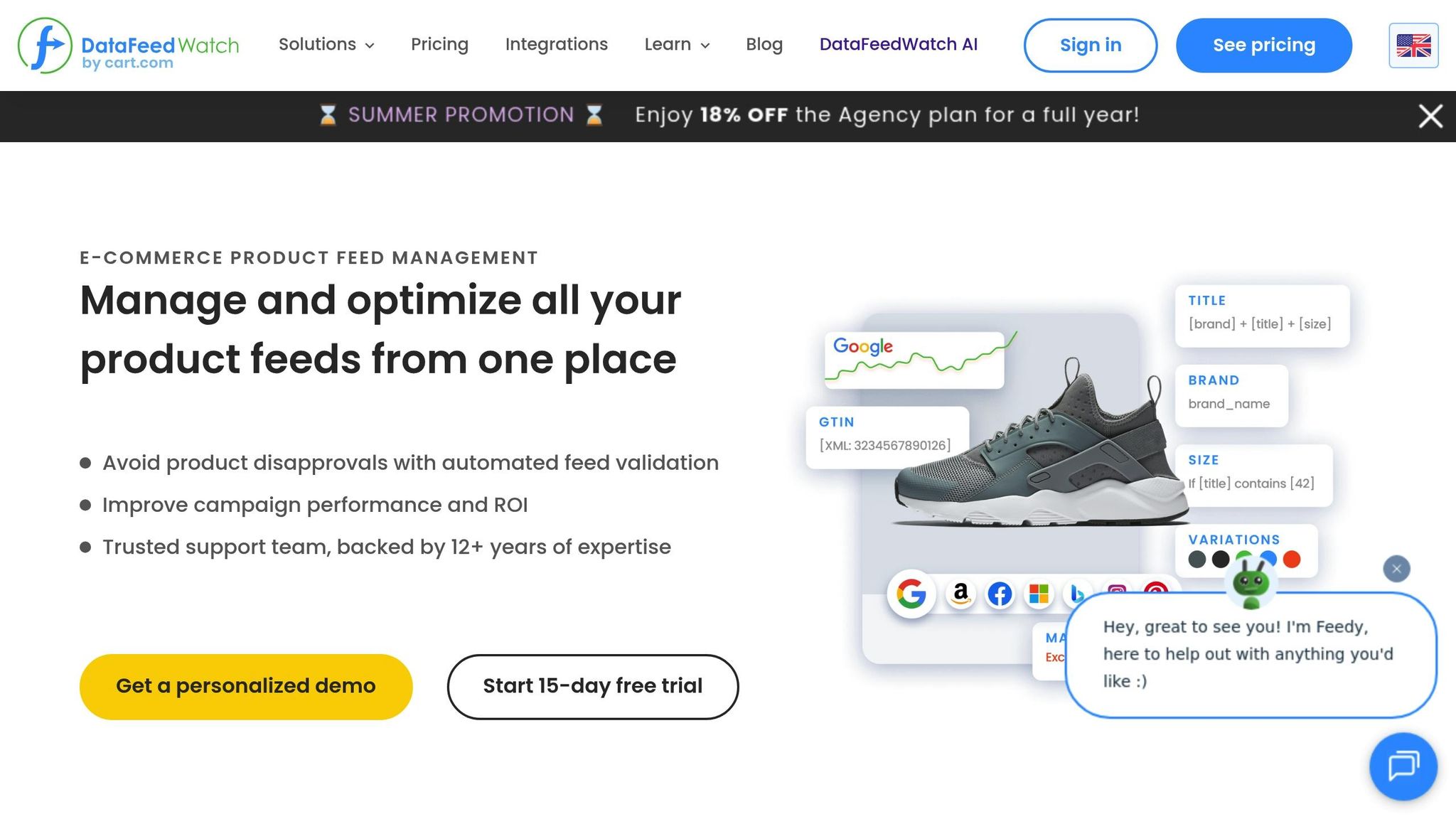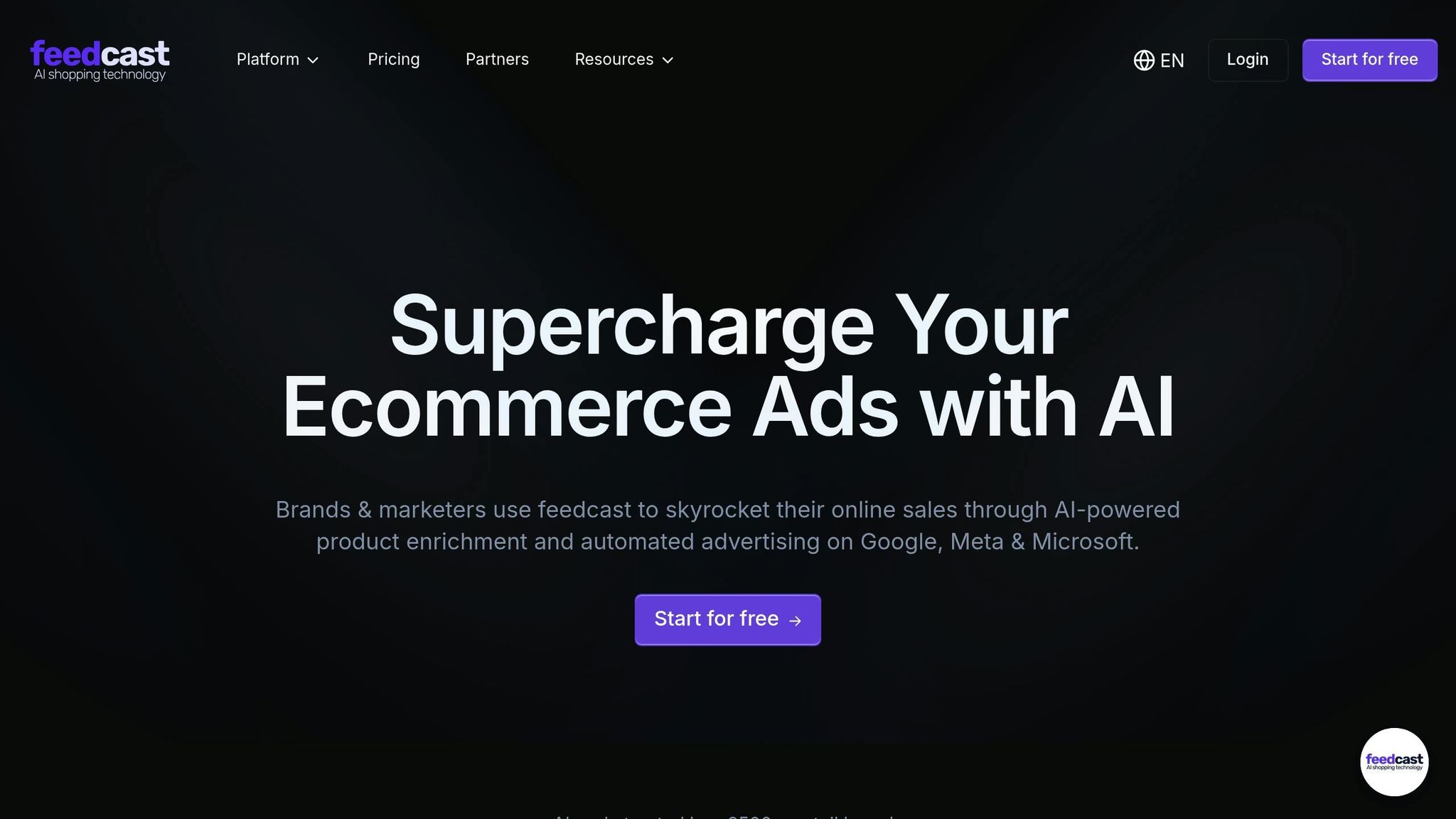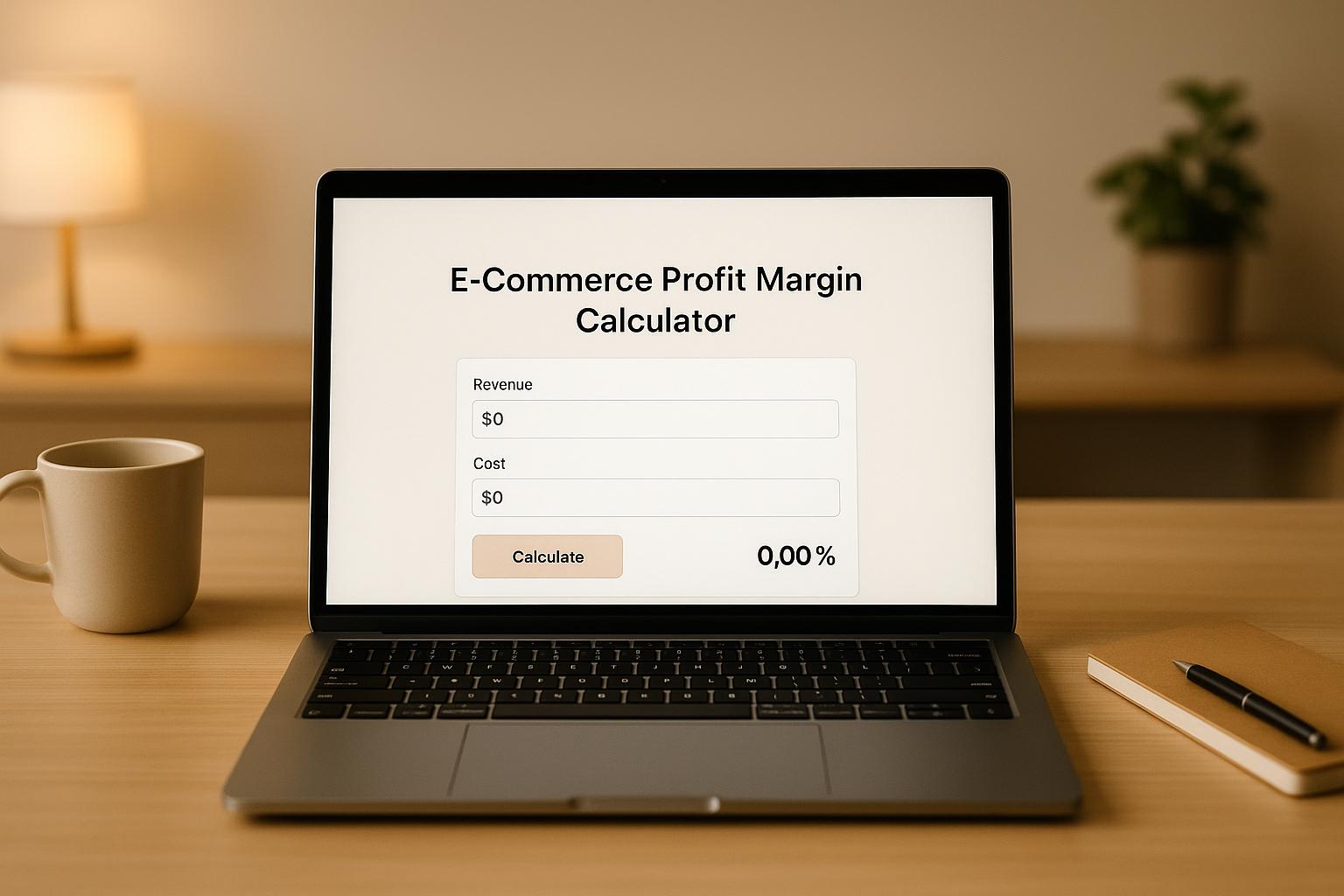AI vs. Manual Product Feed Management
Managing product feeds is critical for e-commerce success. Here's the bottom line: AI-powered systems save time, reduce errors, and handle large catalogs efficiently, while manual methods offer control but require significant effort and are prone to mistakes.
Key Takeaways:
- Manual Management: Labor-intensive, time-consuming, and error-prone. Suitable for small catalogs but struggles with scalability and multi-platform requirements.
- AI-Powered Solutions: Automate updates, ensure accuracy, and optimize performance across platforms. Ideal for growing businesses with complex needs.
Quick Overview:
- Manual: Better for small, static catalogs. Requires constant attention and effort.
- AI: Excels with large inventories, frequent updates, and multi-channel advertising. Saves time and improves accuracy.
For businesses scaling operations or managing diverse product catalogs, AI tools like Feedcast provide centralized, automated solutions that simplify feed management and improve ad performance.
Save Time With Your Data Feed Management By Leveraging DataFeedWatch’s AI Advancements

Manual Product Feed Management: Process and Challenges
Managing product feeds manually requires constant attention and effort to keep product data accurate and up-to-date across various advertising platforms. While this hands-on approach allows for precise control over details, it becomes increasingly difficult to maintain as businesses grow and their product catalogs expand.
Steps in Manual Product Feed Management
The process starts with gathering and organizing product data. This includes pulling information from your e-commerce platform, inventory system, supplier databases, and marketing materials. You'll need to compile product titles, descriptions, prices (in USD), stock levels, images, and specific details like size, color, and material for every product variation.
Once the data is collected, the next step is attribute mapping and categorization. Different platforms require different data formats and structures. For instance, Google Shopping has specific product categories and attribute requirements, while Facebook's catalog may need the same data in a completely different format. This step often involves manually aligning your data to fit each platform's unique specifications.
Data entry and formatting are where things get even more tedious. You’ll need to input product details into spreadsheets or platform-specific templates. For businesses with multiple product variations, this could mean creating separate entries for every size and color combination, ensuring prices follow the $XX.XX format, and maintaining consistent naming conventions across all platforms.
After data entry, error detection and correction come into play. This requires a careful review of your feed to identify missing data, incorrect prices, duplicate entries, or formatting mistakes. As your product catalog grows, these errors become harder to catch, and even a small oversight can lead to problems down the line.
Finally, you’ll upload and monitor your feeds across platforms. This involves manually uploading CSV or XML files, checking for approval statuses, and addressing any rejection notices or compliance issues that arise.
Challenges of Manual Feed Management
The difficulties of managing product feeds manually increase as your catalog and advertising efforts expand.
One of the biggest challenges is the time commitment. Even a moderately sized product catalog demands hours of work each week to keep everything updated. With constant price changes, inventory updates, and new product launches, manual maintenance can quickly overwhelm small teams, pulling focus away from other important tasks.
Human error is another significant issue. Mistakes like incorrect pricing, mismatched product variants, outdated stock levels, or inconsistent titles across platforms are common when handling large amounts of data. These errors can hurt your ad performance, lead to disapproved listings, and create a poor experience for potential customers.
Scaling your operations with manual methods also becomes increasingly difficult. While this approach might work for a small selection of products, it’s nearly impossible to manage larger catalogs with numerous variations across multiple platforms without dedicating substantial resources.
Compliance with platform requirements adds another layer of complexity. Platforms like Google, Facebook, and Microsoft frequently update their product data guidelines and policies. Keeping up with these changes requires constant monitoring, and failing to adapt can result in feed rejections or reduced ad visibility.
Maintaining consistency across channels is another hurdle. A product title optimized for Google Shopping might not meet the character limits for Facebook ads. Ensuring consistent branding and messaging while adapting to each platform’s specific needs requires careful attention, which can be hard to sustain manually.
Lastly, manual feed management often focuses on maintaining basic accuracy rather than optimizing performance. Tasks like refining product titles for better search visibility, testing descriptions to improve conversions, or analyzing data for growth opportunities are typically overlooked. This reactive approach can leave significant potential for improved campaign performance and ROI untapped.
AI-Powered Product Feed Management: Capabilities and Benefits
Managing product feeds manually can be a tedious and error-prone process. AI brings a solution to the table by automating these tasks, making them faster, more efficient, and scalable. Let’s dive into how AI simplifies feed management and the benefits it offers.
How AI Automates Feed Management
AI integrates directly with your e-commerce and inventory systems, syncing product data in real time. This means any updates to prices, inventory levels, or new product launches are instantly reflected in your product feeds. Your advertising platforms always display the most up-to-date information, eliminating delays and manual updates.
Another standout feature is automated data enrichment. AI analyzes your product titles and descriptions, enhancing them with more detailed and relevant information. For instance, a simple title like "Red Shirt" can be transformed into "Men's Classic Red Cotton Button-Down Shirt", making it more descriptive and search-friendly.
AI also handles platform-specific formatting effortlessly. Each advertising channel - whether it’s Google Shopping, Facebook, or others - has unique requirements, and AI ensures your feeds meet these specifications without the need for manual adjustments.
Bulk updates become a breeze with AI. Whether it's applying pricing rules or editing attributes across thousands of products, AI can execute these changes instantly. And when it comes to errors, AI doesn’t just detect them - it either fixes issues like missing fields or broken links automatically or flags them with actionable recommendations.
The result? A streamlined process that not only saves time but also boosts the effectiveness of your campaigns.
Key Benefits of AI-Powered Feed Management
One of the most immediate advantages of AI-powered feed management is the time savings. Tasks that once took hours of manual effort now run in the background, freeing your team to focus on strategic priorities like campaign planning or customer engagement.
AI also improves ad performance by optimizing product data for better visibility and engagement. Enhanced titles and descriptions help your products rank higher in search results, while tailored optimizations increase click-through rates. AI can even analyze which attributes resonate most with your audience and apply those insights across your catalog.
Scalability is another major benefit. Whether you’re managing a few hundred products or an extensive catalog of 100,000 items, AI handles the workload seamlessly. This is especially valuable for growing businesses that may not have the resources to expand their teams.
Accuracy is significantly improved as well. AI eliminates common human errors like typos, missed updates, or duplicate entries. This reliability translates into higher ad approval rates and fewer customer complaints about outdated or incorrect information.
Compliance with platform requirements is handled automatically. AI systems stay updated with the latest guidelines from platforms like Google, Facebook, and Microsoft, ensuring your feeds always meet their standards. This minimizes the risk of disapprovals and keeps your campaigns running smoothly.
Finally, performance optimization is ongoing. AI continuously tests and refines product data, experimenting with title formats, pricing, and categorization to identify what works best. These adjustments are based on actual performance data, not guesswork, ensuring your campaigns are always improving.
Feedcast: A Centralized AI-Powered Solution

Feedcast is a platform that brings all these AI capabilities under one roof. It connects directly with e-commerce platforms like Shopify, WooCommerce, and PrestaShop, syncing product data automatically without the need for manual uploads.
The platform’s AI-powered product enrichment enhances your titles, descriptions, and attributes to improve visibility and performance. This ensures your products are properly categorized and include keywords that potential customers are searching for.
Feedcast also simplifies multi-channel management. From a single dashboard, you can oversee product feeds for platforms like Google Shopping, Facebook, Instagram, and Microsoft Ads. No more juggling multiple logins or managing separate feeds - everything is centralized for convenience.
Pricing is flexible to suit businesses of different sizes. The Autopilot plan costs $99 per month and supports up to 1,000 products with 500 AI credits for automated enhancements. Larger businesses can opt for the Premium plan at $249 per month (discounted to $149 for the first month), which covers up to 100,000 products with unlimited AI credits and channels.
Feedcast also offers performance analytics, providing detailed insights into how your products perform across various platforms. You’ll see which items drive the most engagement, which channels deliver the best ROI, and where there’s room for improvement. This data-driven approach helps you make smarter decisions about pricing, inventory, and marketing strategies.
As a Google CSS partner, Feedcast provides added advantages for Google Shopping campaigns, such as potential cost savings on ad spend. Additionally, the platform’s free channel broadcasting feature extends your reach by submitting products to free listing opportunities like Google Shopping’s free listings, all without extra advertising costs.
Feedcast exemplifies how AI can revolutionize product feed management, making it easier, faster, and more effective for businesses of all sizes.
sbb-itb-0bd1697
AI vs. Manual Product Feed Management Comparison
Choosing between AI-powered and manual feed management requires understanding their key differences. Factors like speed, accuracy, and scalability reveal how AI solutions, such as Feedcast, simplify tasks that manual methods often find overwhelming.
Speed and Efficiency:
Managing product feeds manually takes a lot of time and effort, requiring frequent updates and adjustments. On the other hand, AI-powered systems handle updates quickly, saving significant time and resources.
Error Reduction:
Human errors - like typos, overlooked updates, or formatting inconsistencies - are common in manual processes. AI systems automate these tasks, helping to minimize such mistakes.
Data Enrichment:
Manually improving product information can be inconsistent and time-consuming. AI solutions streamline this process, ensuring product data is clear, organized, and optimized.
Comparison Table: AI vs. Manual Management
| Factor | Manual Management | AI-Powered Management |
|---|---|---|
| Processing Speed | Slow; requires significant manual effort | Fast; processes updates quickly and efficiently |
| Accuracy | Prone to human error and inconsistency | Consistently accurate with automated checks |
| Scalability | Limited by available human resources | Easily handles large catalogs |
| Data Enrichment | Relies on subjective, manual input | Automatically optimizes data based on insights |
| Platform Compliance | Requires manual tracking of policy changes | Adapts automatically to new platform policies |
| Cost Structure | Labor costs rise with catalog size | Fixed subscription pricing, cost-efficient at scale |
| Real-time Updates | Requires manual intervention for updates | Updates occur in real-time |
| Multi-channel Management | Separate processes for each platform | Centralized management across all channels |
| Performance Optimization | Involves manual reviews and adjustments | Continuous, automated optimization |
| Setup and Training | Steep learning curve with ongoing training needs | Quick setup with intuitive automation |
This side-by-side comparison highlights the operational advantages of AI-based solutions over traditional manual methods.
Cost Implications:
Labor costs can skyrocket as your product catalog grows under manual management. In contrast, AI platforms like Feedcast use a fixed subscription model, which becomes increasingly cost-effective as your catalog expands. This predictable pricing structure offers a clear financial advantage for growing businesses.
Compliance and Ease of Use:
Keeping up with constantly changing platform requirements is a challenge with manual processes, requiring constant monitoring. AI-powered systems, however, automatically adjust to policy updates, allowing your team to focus on more strategic priorities.
Quality Consistency:
As product catalogs grow, maintaining consistent quality with manual methods becomes harder. AI solutions ensure product data remains accurate and optimized, enabling businesses to scale without sacrificing quality or efficiency.
Factors to Consider When Choosing a Feed Management Approach
Picking the right feed management strategy depends heavily on your business's specific needs and growth plans. There's no universal solution here - the choice between AI-powered tools and manual methods requires a close look at your current operations and future goals. Below are some key factors to help you decide which approach aligns best with your business.
Key Factors for U.S. E-commerce Businesses
Catalog Size and Complexity
If your product catalog is small, manual management might be sufficient. However, as your inventory grows and becomes more diverse, managing it manually can become overwhelming. In such cases, AI-powered platforms like Feedcast can handle the workload much more efficiently.
Update Frequency Requirements
For businesses that only need occasional updates - say, once a week or month - manual management might work fine. But if you're in a market where prices change daily, inventory fluctuates often, or seasonal updates are frequent, automation can save significant time and effort by keeping everything up to date seamlessly.
Multi-Platform Advertising Strategy
Advertising across multiple platforms like Google Shopping, Facebook, Instagram, and Microsoft Ads requires different feed formats and compliance with various policies. Manually managing feeds for each platform can quickly become complicated and prone to errors. AI tools simplify this process by centralizing management.
Available Internal Resources
Take a hard look at your team's capacity. Time spent on manual updates could be better used on activities like market research, customer engagement, or product innovation. Often, the cost of human hours spent on manual tasks outweighs the price of an AI-powered solution.
Technical Expertise and Infrastructure
Manual feed management requires a detailed understanding of platform specifications and constant monitoring. Platforms like Feedcast offer user-friendly interfaces, making it easier for teams without deep technical expertise to manage product feeds effectively.
Budget Considerations
While manual methods may seem cost-effective initially, they come with hidden expenses like employee hours, errors leading to ad disapprovals, and missed sales due to outdated information. Feedcast’s scalable pricing - starting with a free tier and going up to $99 per month for up to 1,000 products - can often be a more economical choice as your catalog and business grow.
These factors highlight when automation becomes a smarter choice than manual management.
When to Choose AI Over Manual Management
Certain scenarios make AI-powered solutions the clear winner over manual methods.
Rapid Growth Phases
If your product catalog is expanding quickly or you're entering new markets, manual processes can slow you down. Automation ensures accuracy and efficiency, even as your business scales.
Competitive Market Conditions
In fast-moving markets where competitors frequently adjust pricing or introduce new products, staying responsive is critical. AI tools allow for real-time adjustments, helping you stay competitive.
Multi-Channel Expansion Plans
Expanding your advertising to multiple platforms? AI-powered systems like Feedcast simplify the process by centralizing feed management and optimizing performance across all channels from one dashboard.
Data Quality Challenges
If you’re dealing with frequent feed disapprovals, inconsistent product information, or poorly optimized product titles and descriptions, it’s a sign your feed management needs an upgrade. AI solutions can automatically enhance and standardize your data.
Resource Allocation Priorities
When your team’s time is better spent on strategic initiatives like customer acquisition or product development, automation can take over routine feed tasks, freeing up valuable resources.
Seasonal Business Fluctuations
Businesses with seasonal spikes - like those selling holiday decorations or summer gear - need a system that can handle sudden changes in inventory and traffic without requiring extra management effort. AI tools excel in managing these fluctuations smoothly.
The choice ultimately depends on your business's current capabilities and long-term goals. While manual methods might work for small, static catalogs, most growing U.S. e-commerce businesses will find that AI-powered platforms like Feedcast provide the scalability, accuracy, and efficiency needed to thrive in today’s competitive environment.
Conclusion: AI vs. Manual Product Feed Management
Choosing between AI-powered and manual product feed management isn't just about ease of use - it's about staying competitive in the fast-paced world of e-commerce. While manual methods might suffice for smaller catalogs with occasional updates, the evidence strongly favors AI automation as the better long-term approach for most businesses in the U.S.
AI-powered tools don't just simplify processes - they deliver tangible results. For instance, they improve ad relevance, which directly enhances ad performance for e-commerce businesses[1][2]. This makes them a powerful ally in driving better outcomes from advertising campaigns.
One of the standout advantages of AI is scalability. As your catalog grows, managing product feeds manually becomes increasingly challenging and error-prone. By contrast, AI systems can handle thousands of SKUs across multiple channels with minimal effort, maintaining accuracy and consistency that manual processes often struggle to achieve[4]. This not only saves time but also ensures your data remains reliable.
In today’s competitive e-commerce environment, real-time synchronization is no longer optional - it’s a necessity. AI automates updates for pricing, inventory, and product descriptions, ensuring that all connected channels stay current and aligned[4]. This eliminates discrepancies that could harm customer trust or sales.
For U.S. businesses ready to embrace this shift, platforms like Feedcast offer practical solutions. They centralize feed management, automate data enrichment, and detect errors in real time. Plus, the cost structure is accessible, starting at $0 for basic features and scaling to $99 per month for up to 1,000 products. The efficiency gained often offsets these costs, reducing operational expenses while improving overall performance.
The move toward AI-driven feed management mirrors a growing trend in e-commerce as businesses aim to optimize their presence across multiple advertising platforms[1][3]. It’s a shift that’s hard to ignore for those looking to stay ahead.
FAQs
How does AI improve product feed management and boost ad performance compared to manual methods?
AI-driven product feed management takes ad performance to the next level by automating critical tasks like refining product titles, descriptions, and attributes. The result? Ads that are more relevant and eye-catching, leading to better targeting and stronger connections with potential customers.
Compared to traditional manual methods, AI works tirelessly to optimize campaigns by analyzing real-time data and fine-tuning strategies on the fly. This approach doesn’t just save time - it ensures smarter use of your ad budget, boosts conversion rates, and delivers a higher return on investment (ROI).
What should e-commerce businesses consider when choosing between AI-powered and manual product feed management?
When weighing the choice between AI-powered and manual product feed management, it's essential to think about factors like efficiency, scalability, and how well the solution supports your business's growth over time. AI tools can handle tasks like data enrichment, spotting errors, and optimizing campaigns automatically. This not only saves time but also cuts down on the need for manual effort - something that becomes increasingly important as your product catalog grows or you start advertising across multiple platforms.
While manual feed management might be fine for smaller operations with limited product data, it can quickly become overwhelming as your business expands. AI-driven tools offer consistent, data-focused insights, simplify managing multiple channels, and enhance campaign performance. This means better ROI and a stronger ability to keep up in the fast-moving world of e-commerce.
Can AI tools like Feedcast automatically ensure compliance with advertising platform requirements?
AI tools, such as Feedcast, can make compliance tasks much easier by automating processes like verifying product data accuracy, following platform rules, and ensuring brand safety. They are built to simplify these efforts across major advertising platforms, including Google, Meta, and Microsoft Ads.
That said, while AI is great for handling many compliance-related tasks efficiently, some complex or region-specific legal requirements might still need a human touch. Pairing AI automation with periodic manual reviews can help ensure your campaigns fully meet all necessary standards.
Geoffrey G.




